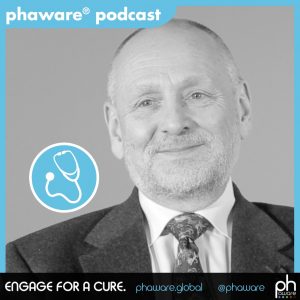Phaware Podcast: Brian Hanna, MDCM

This podcast series, created and produced by phaware, is being offered as a regular guest feature on Pulmonary Hypertension News to bring the voices and life experiences of PH patients, family members, caregivers, healthcare specialists, and others to our readers. You may listen to the podcast directly, or read it via the transcript that runs below.
I’m Aware That I’m Rare: Brian Hanna, MDCM
The phaware® interview (Episode 97)
Brian D. Hanna, MDCM, PhD, FAAP, FACC, is a board-certified cardiologist and director of the Section of Pulmonary Hypertension at Children’s Hospital of Philadelphia. His research Interests include: natural history of pediatric pulmonary hypertension, treatment trials for pulmonary hypertension, and the role of pulmonary hypertension in congenital heart disease. Hanna discusses pediatric cardiology and innovative pulmonary hypertension research.
My name is Brian Hanna, I run the pulmonary hypertension program at the Children’s Hospital of Philadelphia.
I’ve been at it for a while. I’m considered to be one of the “old men.” Yet, from a work point of view, my role has been as a clinician. Yes, I have done many other  things as a pediatric cardiologist, but in pulmonary hypertension I look after and I play with kids.
things as a pediatric cardiologist, but in pulmonary hypertension I look after and I play with kids.
We have developed a program in our institution, which is rather large, and because of that I think that we have, in some small way, advanced some of the science, some of the understanding. It is unbelievably exciting for me to see the change that has happened in the way in which pediatric pulmonary hypertension has advanced the science and the understanding.
What is this disease? This is a very simple question that most of us, in my mind, don’t understand. I am a heart failure cardiologist. What I mean by that is that whatever makes the heart not work well enough for a child to do whatever he or she wants to do, then it’s my job to make that heart work better. In the face of this disease, pulmonary hypertension, it is the right side of the heart that doesn’t work well. Over the years I have gone from being a heart transplant, lung transplant, catheterization physician to this; (it) is all that I do now. I look after the right heart in children with pulmonary hypertension.
The disease in children is, in a lot of ways, at the forefront of being incredibly exciting. There are many people across the world with what we are considering idiopathic or genetic — we also call it Group 1 pulmonary arterial hypertension. Yet, in small children this is a rare and small part of what we do.
Most of our children will have pulmonary hypertension on the basis of lung disease, being born too early, complex abnormalities in their lung, from heart disease, being born with holes or obstructions. As we see more and more of these children, we are learning more and more about the relationship between the right heart and the pulmonary vascular bed. One of the [Robyn J. Barst Pediatric Research and Mentoring Fund] recipients is looking at the way in which the lung grows and develops in small infants and small babies, especially children who have injury to lung, as in premature infants. This work, I think, is impressively exciting because what it is telling us is what is wrong in the vascular bed, in the heart, in small babies, and therefore what can we fix.
Dr. Frank’s work [David Brian Frank, MD, PhD], in addition, has also shown us other things about children. He and a mathematics pulmonary hypertension physician from Winnipeg, Canada have developed a mathematical model of the pulmonary vascular bed. This is not something you get from an imaging modality. This is something that lives in a computer, if you will. This mathematical model is quite complex but very simple to use.
After a cardiac catheterization, I can enter into the model simple information about the child and about the results of the catheterization. I can estimate, based on this model, the percentage of the vascular bed that is available for flow. This also, if you look at it the other way, is the percentage of the vascular bed that has been lost.
Now, this is the first time in my life that I have been able to be able to say, “I understand whether a drug works or not,” because if it works, it’s not going to make the six-minute walk better; it’s not going to make the B-Type Natriuretic Peptide (BNP) blood test better. It’s going to give me more blood vessels. That’s what I want.
In these types of models, looking at small babies, treating them with the therapies that we have, I can tell you whether or not their vascular beds become normal or not. And, excitingly, it’s the only true model of pulmonary hypertension in a human that I can say I can treat, and that I can prove that I can treat.
That, to me, is amazing. Because what it is telling me is that there are things that we can do for all children and, therefore, maybe even adults, to make this not a progressive and very difficult disease to live with, but maybe a chronic disease and maybe a curable disease.
EVERYBODY HAS A STORY. WHAT’S YOURS?
Phaware global association wants to share your pulmonary hypertension story with their engaged global audience. Whether you are a patient, caregiver, or medical professional, they are enlisting PH community members from around the world. Visit www.phawarepodcast.libsyn.com/contact to share your story and to be considered for a future episode. Never miss an episode with the phaware® podcast app. Learn more about pulmonary hypertension at www.phaware.global. #phaware
***
Note: Pulmonary Hypertension News is strictly a news and information website about the disease. It does not provide medical advice, diagnosis, or treatment. This content is not intended to be a substitute for professional medical advice, diagnosis, or treatment. Always seek the advice of your physician or other qualified health provider with any questions you may have regarding a medical condition. Never disregard professional medical advice or delay in seeking it because of something you have read on this website. The opinions expressed in this column are not those of Pulmonary Hypertension News or its parent company, Bionews Services, and are intended to spark discussion about issues pertaining to pulmonary hypertension.










Leave a comment
Fill in the required fields to post. Your email address will not be published.